 A milk run is a popular way to supply materials to multiple locations. It can easily be combined with a pull system like kanban, where it merely replenishes what was consumed. But what are the best uses for milk runs? And when do you use them, and when would another logistics system be better? This post points out where the milk run shines and where you should consider alternatives.
A milk run is a popular way to supply materials to multiple locations. It can easily be combined with a pull system like kanban, where it merely replenishes what was consumed. But what are the best uses for milk runs? And when do you use them, and when would another logistics system be better? This post points out where the milk run shines and where you should consider alternatives.
Intro
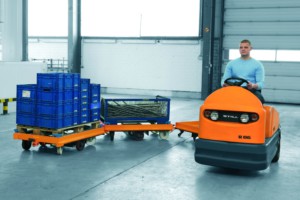 For this post, I consider a milk run a type of transport that
For this post, I consider a milk run a type of transport that
- Transports materials between more than two locations (often one source and multiple destinations, but occasionally multiple sources and one destination)
- Transports more than one item at a time
- Has a regular schedule or timetable and is not simply on demand.
Ideally, this is managed using a pull system like kanban, but you can also “push” material through a milk run. I have written a whole series on milk runs before, starting with Introduction to Milk Runs. In this post, I will look at when a milk run makes sense and when other logistic systems may be better.
Volume and Frequency of Demand
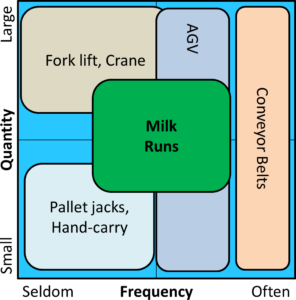
The first thing to consider for a milk run is the volume and frequency of demand. How much material are you dropping off at a destination, and how often? How much do you pick up from a source, and how often? With volume, I mean not so much the number of items, but the actual volume of these items. Here, milk runs are best for a middle ground.
Milk runs work best if they run regularly and use the available space on the milk run. If you have to transport a lot of material within a given period, it may be possible to use multiple milk runs on the same route or split the route into smaller routes, again with separate milk runs for each route. It is completely doable. However, the larger your material stream becomes, the better it may be to use a dedicated transport system like a conveyor belt or a dedicated vehicle. If you transport so much material from one source to one destination that a single milk run is plenty busy, then it is no longer a milk run but a dedicated transport.
On the other hand, if you have very little material to transport, a milk run may run far below its capacity. Here you could add more stops to the milk run or run the milk run less frequently (at the cost of having more material to cover the time between milk runs, i.e., you increase fluctuations). You could also make the milk run smaller. But in its extreme, the milk run may carry only a single item along multiple stops. In this case, it may also make sense to stop running a milk run and instead just bring the items as needed. A pallet jack or even an operator carrying a small box may be better than having a milk run make multiple stops that do not drop off material or pick up an empty box, or a very infrequent milk run with lots of material at the source and destination due to increased fluctuation. For bulkier goods that are hard to put on a pallet jack, a forklift may be best.
Size and Cost of the Goods
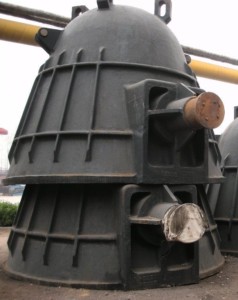
Another factor is the size and the cost of the goods. A milk run needs some material both at the source and at the destination to cover its fluctuations. The destination needs enough material to cover the time until the milk run can replenish the goods (roughly two cycles worth of material; see my post on Calculating the Material for Your Milk Run for more). The source needs also enough material to fill up the milk run again.
The larger your items are, the more space is needed for storage at both the source and the destination. The more expensive your items are, the more capital is tied up as inventory. Both tied-up capital and filled-up space are bothersome and costly. You could run your milk run more often to reduce inventory, but for very costly and very large items, another approach closer to Just in Time (JIT) may be better. Maybe you have a dedicated on-demand supply for the largest and most expensive parts?
Small and inexpensive parts, on the other hand, are perfectly fine for a milk run. At what size or cost a material is better handled with a dedicated transport depends very much on your system. Maybe everything you have can be on a milk run. Maybe nothing is suited for a milk run.
Distance (i.e., Travel Time)
 Finally, there is the question of distance. Or, to be more precise, the time it takes for a milk run to do a route. Here, too, the middle ground is best. I find milk runs in factories often are set up for a tour between thirty minutes and two hours. For external milk runs across different factories and warehouses, the duration of a milk run can even be a day or two.
Finally, there is the question of distance. Or, to be more precise, the time it takes for a milk run to do a route. Here, too, the middle ground is best. I find milk runs in factories often are set up for a tour between thirty minutes and two hours. For external milk runs across different factories and warehouses, the duration of a milk run can even be a day or two.
But nobody (to my knowledge) runs a milk run from China to the USA or Europe. The duration of a milk run is the main driver for the inventories needed to cover the replenishment time. And, having multiple milk runs on the same route does make only a small difference. Hence, the longer the route the more material is needed to cover fluctuations, and at one point a normal shipping just makes more sense than a milk run.
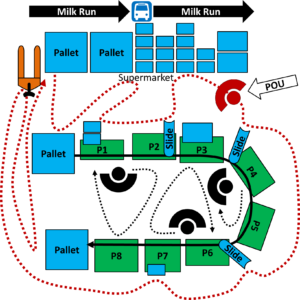
For very short distances within a plant, it may also not be sensible to use a milk run. You could also use a dedicated system. Or, even better, you could use a point of use provider (POU). A point of use provider is similar to a milk run, but does not operate on a schedule. Instead, the material is delivered as needed. This requires a lot of attention to the system to know what is needed when, but especially around an assembly system this works well in many factories.
Overall, there may be many considerations for when to use a milk run and when not. The details may also depend very much on your production system, and what works for one may not work for another. In any case, I hope these considerations are helpful to you. Now, go out, get your material flow structured, and organize your industry!

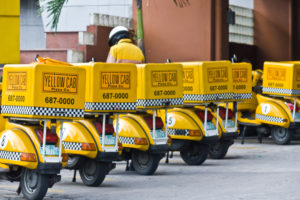
Hi Christopher,
thank you very much for this article. well explained and very valuable.
I would like to add that is quite easy to handle heavy part (less than 500kg) in a Milk run flow. In our company we used to provide pallets (with a tugger train) with pallet on wheel equipment. this solution avoid to have wide corridor needed for forklift or stapler. This solution allows us to transport pallet with a maximum weight of 500kg included in a milk run flow. for sure, this solution is valuable when the consumption is more than several times a day.
A second comment in your article is about the frequency, this is a trigger point to implement milk run. Our rule for milk run is fixed schedule, variable quantity and we mix the kind of parts to be transported (small and medium). For the large parts (less than 500kg), we have a specific milk run.
Hi Serge, definitely. I have seen such pallet carts in a milk run train quite frequently. But you do need some tools to move it in and out of the cart, e.g. a small forklift or similar.